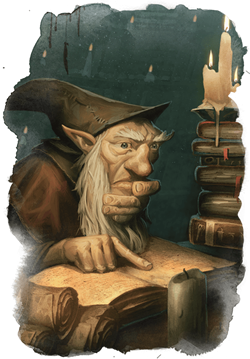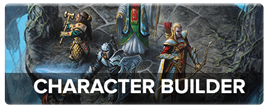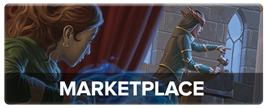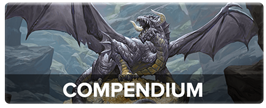 New Player’s Guide is going on hiatus, giving us some space to return to beloved series like Class 101, Spell Spotlight, How to Play Monsters, and to explore new ideas. In the meantime, however, we want to know what D&D questions are burning in your mind, so that we can answer them once we come back. Reply to the comments of this post with ONE question for D&D Beyond’s Lead Writer James Haeck.
New Player’s Guide is going on hiatus, giving us some space to return to beloved series like Class 101, Spell Spotlight, How to Play Monsters, and to explore new ideas. In the meantime, however, we want to know what D&D questions are burning in your mind, so that we can answer them once we come back. Reply to the comments of this post with ONE question for D&D Beyond’s Lead Writer James Haeck.
We’re looking for questions about Dungeon Master skills, player tips, dungeon design, encounter design, magic item design, monster design, and anything else that will help you be the best DM or player you can be!
When New Player’s Guide returns from hiatus, we’ll have combed through your questions with a particular eye for ones that will benefit the entire D&D Beyond community. We can’t wait to read your questions!
Create A Brand-New Adventurer Acquire New Powers and Adventures Browse All Your D&D Content
 James Haeck is the lead writer for D&D Beyond, the co-author of Waterdeep: Dragon Heist, Baldur's Gate: Descent into Avernus, and the Critical Role Explorer's Guide to Wildemount, a member of the Guild Adepts, and a freelance writer for Wizards of the Coast, the D&D Adventurers League, and other RPG companies. He lives in Seattle, Washington with his fiancée Hannah and their animal companions Mei and Marzipan. You can find him wasting time on Twitter at @jamesjhaeck.
James Haeck is the lead writer for D&D Beyond, the co-author of Waterdeep: Dragon Heist, Baldur's Gate: Descent into Avernus, and the Critical Role Explorer's Guide to Wildemount, a member of the Guild Adepts, and a freelance writer for Wizards of the Coast, the D&D Adventurers League, and other RPG companies. He lives in Seattle, Washington with his fiancée Hannah and their animal companions Mei and Marzipan. You can find him wasting time on Twitter at @jamesjhaeck.











-
View User Profile
-
Send Message
Posted Sep 28, 2020And lastly how keep a campaign interesting and engaging?
-
View User Profile
-
Send Message
Posted Sep 29, 2020Yes. I agree.
-
View User Profile
-
Send Message
Posted Oct 19, 2020If you're a kobold with 6 STR, can you heal people by punching them? It's -1 damage...
-
View User Profile
-
Send Message
Posted Oct 20, 2020No, an attack that hits and can deal damage always deals one damage, if the creature you are trying to hit has immunity or resistance it just deals zero damage.
-
View User Profile
-
Send Message
Posted Oct 20, 2020So an unarmed strike does a minimum of 1 damage? I thought it was just straight up 1 + STR mod. And if you build a character on DDB who has -1 STR, the character sheet shows the unarmed strike as doing 0 damage.
I wasn't actually serious, by the way.
-
View User Profile
-
Send Message
Posted Oct 21, 2020I find spending a little time with the dmg or xanithar random tables give me inspiration, and the there are other online resources that can help with that too. The source books have a ton of stuff to draw from.
-
View User Profile
-
Send Message
Posted Oct 27, 2020I am running a campaign and i am wondering if i need zoom or anything for the ADVENTURE. lastly i am wondering how to get the campaign out to lots of people.
-
View User Profile
-
Send Message
Posted Oct 27, 2020For a campaign, it's typically best to have a group of 3 to 6 people. If you don't have players yet, then when you're ready to start, you can go to the D&D Beyond Forums, find the Looking for Players and Groups section, and post there. You can also look through the people who are looking for groups to join and respond to their posts.
As for Zoom, I play online using Discord voice chat and text chat, and that works well enough for me. Discord has a video chat feature, but I haven't used it. Zoom would work for a video chat campaign just as well, though, I think.
Hopefully that helps a bit! If you have more questions like that, let me know. :)
-
View User Profile
-
Send Message
Posted Oct 28, 2020another question is Could I play with people I do not know?
-
View User Profile
-
Send Message
Posted Oct 29, 2020Yeah you could, but then you wouldn't know their mannerisms until after the fact (e.g. I either play nontypical [think brutish rogue] or cold nasty characters, but I digress). But that's what Session Zero is for
-
View User Profile
-
Send Message
Posted Oct 29, 2020Yeah, you can play with people you don't know. That said, I'd personally recommend individually talking to people you're considering DMing for even before session zero to make sure that you'll enjoy their style, that they'll enjoy your style, and that they're cool with playing a campaign run by (I'm guessing here) someone new to DMing. Once you've picked the people you think are a good fit for your group (again, three to six; more than that and it would probably get overwhelming for you), then you would want to have a session zero.
Although I've heard of people who started with D&D as a DM, I'd recommend starting as a player first if you haven't played before and you possibly can. :)
-
View User Profile
-
Send Message
Posted Nov 20, 2020You can do this cheaply by using a few clichés. If you want a fairly standard opening, you can have a character's contact(s) ask them to go some unknown local. This opening was used in Tomb of Annihilation and Princes of the Apocolypse. You can use the spontaneous starting quest start by having an NPC ask the heroes to go on a quest. This was used in Waterdeep: Dragon Heist, Icewind Dale: Rime of the Frostmaiden, and Baldur's Gate: Descent into Avernus. You might take a page out of Dragon Heist's book by having abrupt combat prove the hero's skills. I once started a campaign like this by having a theatre troop kidnapped and the characters enlisted to help, and another one by having the characters enlisted to rob a museum. Another common clichè is dropping the characters in the middle of an unknown land and telling them to survive, like what we see in Out of the Abyss or Curse of Strahd. Finally, you have the old standby: the characters are in a small village when it comes under siege. This was used in Tyranny of Dragons and Storm King's Thunder.
-
View User Profile
-
Send Message
Posted Nov 20, 2020-
View User Profile
-
Send Message
Posted Nov 21, 2020If they are just looking it's Perception, but if they are putting their hands on it then it's Investigation.
-
View User Profile
-
Send Message
Posted Nov 21, 2020The way I see it, as a general rule, Perception is looking for something; Investigation is seeing something and determining what it means.
-
View User Profile
-
Send Message
Posted Nov 22, 2020I think it is a matter of perception. Do not choose *which* skill to apply, determine *if* a skill applies.
There are a lot of things that involve multiple schools, tool abilities, etc...
For example, it is often common to lie while intimidating someone (deception and intimidation), to need to see something and understand it in order for it to be meaningful (perception and investigation), and for someone to be nimble and strong to escape danger (acrobatics and athletics). Rather than deciding *which* skill applies, I ask the players to tell me what ability score they're using (usually indirectly, by asking how they are approaching it) and then determine if they get to add proficiency (or expertise) to it based upon their skills, tool proficiencies, background and recent history.
So, if the players are checking out a ruin and want to 'investigate the dwarven stone door' (which has a poison gas trap on it), I ask how they're doing it. If they say they're just looking at it, I'll make it a wisdom roll and allow them to add their proficiency modifier if I know that they have either perception skill, trap making abilities, a history with poison gas traps, etc... I end up allowing proficiency rolls more often than other DMs, but it makes them feel like heroes. If they'd said they wanted to look at how the door works, I'd have allowed them to make an intelligence ability check with a proficiency bonus for investigation, for trap making abilities, for experience with poison gas, etc...
-
View User Profile
-
Send Message
Posted Mar 26, 2021if a dragonborn's parents are frost and fire, will the children be water?
-
View User Profile
-
Send Message
Posted Mar 26, 2021Is the player's guide even going to exist with the change over of creative talent? It's been a long, long, long time since it was announced.
-
View User Profile
-
Send Message
Posted Apr 19, 2024how do you buy a race I want to have a sea elf but I don't know how to make it
-
View User Profile
-
Send Message
Posted Apr 19, 2024You make choices matter, and have your world follow a consistent internal logic, even if only as a facade, because once your players know everything is bullshit, then nothing means anything and they don't matter, and if they don't matter to the world then they don't have a reason to keep playing in it.